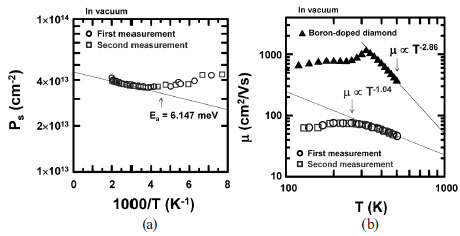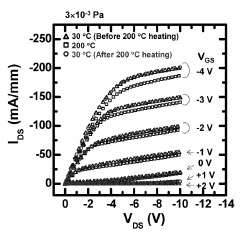1Materials Science Laboratory, 1Physical Science Laboratory, 3Saga University
High-frequency (>100 GHz) operations have been demonstrated for hydrogen-terminated
(H-terminated) diamond field effect transistors (FETs) with a hole accumulation
layer channel [1]. Recently, we revealed that the hole carriers are mainly
generated by nitrogen-dioxide (NO2) adsorpted on the H-terminated surface. However, there still remains a
thermal stability problem: With increasing temperature in a vacuum, the
hole carrier density decreases, most likely due to desorption of the adsorbates.
In this work, to solve the problem, we passivated the H-terminated diamond
surface with Al2O3.
After highly concentrated NO2 adsorption (2% in N2) to the H-terminated diamond surface, a 10-nm-thick Al2O3 passivation layer was deposited by the atomic layer deposition (ALD) method.
Figure 1 shows the temperature dependence of sheet hole concentration (ps)
and hole mobility (µ) of the hole accumulation layer on the passivated
diamond surface. Both ps and µ were the same values in the repeated
measurements. This confirms that the hole accumulation layer on the passivated
diamond surface is thermally stable. In a temperature range > 30ºC,
the ionization energy was estimated to be as low as 6.2 meV. On the other
hand, µ changes in proportion to 1/T (the T-1 rule) for T > 100ºC.
The T-1 rule indicates the degeneration of the hole carriers at higher
temperatures [2].
Next, we applied the Al2O3 passivation technique to diamond FETs. Figure 2 shows the drain current-voltage (IDS-VDS) characteristics of the passivated diamond FET at 200ºC and RT before and after the 200ºC heating in a vacuum. Before the 200ºC heating, the maximum IDS (IDSmax) at RT was -200 mA/mm. At 200ºC, the IDSmax decreased to -180 mA/mm. After the 200ºC heating, the IDSmax increased to the initial value of -200 mA/mm at RT. Before and after the heating, IDS at every VGS clearly agree well with each other. The threshold voltage (Vth) remained constant (+1 V), which implies that the hole density under the gate electrode stayed exactly the same value after the heating cycle below 200ºC. Therefore, the IDS decrease at 200ºC is attributed to the temperature dependence of hole mobility, as observed in Fig. 1(b). These results reveal that the Al2O3 passivated diamond FETs can be operated without thermal degradation at least up to 200ºC.
[1] M. Kasu et al., Electronics Lett. 41 (2005) 1249.
[2] M. Kasu, H. Sato, and K. Hirama, Appl. Phys. Express 5 (2012) 025701.
 |
 |
|||||
|
|